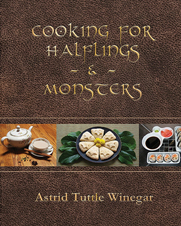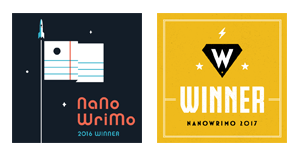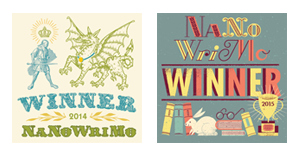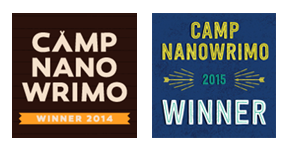 Astrid Tuttle Winegar’s Cooking for Halflings & Monsters: 111 Comfy, Cozy Recipes for Fantasy-Loving Souls (2017) is now in its second edition. According to Astrid, Tolkien scholar and foodie, you don’t need to be a “gourmet monster chef” to enjoy these recipes, you just need to love comfort food. “Lovingly illustrated and written with dry humor throughout, this charming cookbook is sure to delight you and your family, friends, and any other lucky halflings (or monsters) who show up in your kitchen.” Go to Astrid’s website at AstridWinegar.com to learn more about her and discover some great recipes (I’m going to try several under Recipes/Sweeties category). You’ll also find her on Facebook, Twitter, and Pinterest. For a signed copy of the cookbook with free U.S. domestic shipping, visit her Etsy Shop at ElegantSufficiencies.
Astrid Tuttle Winegar’s Cooking for Halflings & Monsters: 111 Comfy, Cozy Recipes for Fantasy-Loving Souls (2017) is now in its second edition. According to Astrid, Tolkien scholar and foodie, you don’t need to be a “gourmet monster chef” to enjoy these recipes, you just need to love comfort food. “Lovingly illustrated and written with dry humor throughout, this charming cookbook is sure to delight you and your family, friends, and any other lucky halflings (or monsters) who show up in your kitchen.” Go to Astrid’s website at AstridWinegar.com to learn more about her and discover some great recipes (I’m going to try several under Recipes/Sweeties category). You’ll also find her on Facebook, Twitter, and Pinterest. For a signed copy of the cookbook with free U.S. domestic shipping, visit her Etsy Shop at ElegantSufficiencies.
 Your love of fantasy (especially Tolkien) and a knack for cooking led to a college project that ultimately became Cooking for Halflings & Monsters. What was the most rewarding aspect of completing the book?
Your love of fantasy (especially Tolkien) and a knack for cooking led to a college project that ultimately became Cooking for Halflings & Monsters. What was the most rewarding aspect of completing the book?
Just actually getting it done. Life interferes constantly with creative work. I approached this experience as a middle-aged person who had never contemplated such a long-term project. I had the gift of time, my children were grown, my college courses were done, and I figured what the heck? I might as well try a different career.
The original published version of the cookbook was titled Astrid’s Modern Hobbit Recipes and included names and places from the Tolkien universe that you later discovered were copyrighted. You then renamed, rewrote, and reworked the book before publishing the current version. What was that process like? Many writers would have been discouraged and let the project go—why didn’t you?
From the beginning I knew there might be copyright issues, but I thought my original publisher and I had grasped fair use laws. A polite letter from the Tolkien Estate disabused us of that notion. When I realized I would have to completely rewrite the book, my original thoughts ran something like, “!@$%^&*((!!!” The original publisher didn’t even respond to my agent after that. I resented that they obviously didn’t review the revised book. By then I had already put in so much time, it seemed such a waste to give it up. The process was aggravating, to put it mildly.
Nevertheless, I persisted! I thought about going with medieval history as a new theme, but that didn’t really appeal to me. Middle-earth is filled with various distinct races of beings, and when I started to think about hobbits, elves, dwarves, and wizards, I suddenly thought I could divide the recipes into similar groupings. This took only about six months to accomplish. In the meantime, my publisher moved on to other things. I finally called my agent and we parted on amicable terms. Then I self-published on Amazon. My entrance to the social media world, specifically Twitter, led to a referral to an independent publisher. They eventually published the book…and then went out of business! Now it’s all me. This is challenging and scary, but also liberating in a way.
As part of the rewrite, you changed the format from following the stories in Tolkien’s universe to a different kind of grouping for the recipes. Tell us about the unique structure of the book.
Yes, the original cookbook strictly followed the text in a linear fashion. My first four chapters dealt with The Hobbit. The first chapter was all about the dwarf invasion of Bag End. The final eight chapters dealt with The Lord of the Rings. The first of these chapters was about Bilbo Baggins’s 111th birthday party. When this structure was no longer available to me, I realized my Prancing Pony chapter was a menu all to its own. That led me to think of other restaurants.
Each chapter ended up being a type of restaurant (such as “Halfling Hideaway” and “Glitnír’s Hall”) that represented each group of typical inhabitants in most any fantasy-themed universe: halflings, men, wizards, dwarves, monsters, and elves. Two other restaurants represent common tropes in fantasy: the council (“Council Catering”) and the quest (“Quest Depot”). The Prancing Pony chapter is pretty much as it was in the original cookbook but is now called “The Inn of the Doughty Hero.” It represents men.
With this new concept, I ended up with a total of eight chapters. This was a fortuitous number, since I happened to have invented eight soups. Thus, the first item on each new menu was a soup. I followed this with a bread or two, then a salad and/or an appetizer, etc. Each menu ends with desserts. Most cookbooks have a soup chapter or a dessert chapter, but mine doesn’t conform to this. Perhaps it might confuse readers/cooks, but I think most people have gotten used to it, and I hope they have found a logical way to pick some new favorite dishes!
How long did it take to develop the complete set of eleventy-one primary recipes? When did you know you had taken the manuscript as far as it could go—that it was finally ready for publication?
Tolkien’s culinary universe is actually rather limited. I started with a list of every single food or beverage he mentions in The Hobbit and The Lord of the Rings, then I expanded from there. I’d say it took around two years to complete 90% of what is currently in the cookbook. My family ate a whole lot of bacon, potatoes, and mushrooms during that time! A few items changed; for example, the original cookbook did not have a recipe for Turkish Delight, but I made a recipe for that after I lost the connection to Middle-earth. Then another year for testing and adjusting, working with about a dozen recipe testers. By the time the cookbook was ready in 2011, I felt I had a complete narrative, as well as 111 delicious recipes. The quest for an agent/publisher took a few more months.
In an alternate Lord of the Rings universe, imagine a cook-off between one of these sets of characters: Samwise vs. Gollum, Frodo vs. Sauron, or Gandalf vs. Saruman. What would the characters cook, and what prize would the winner receive?
In the Middle-earth Mithril Chef challenge, we have Samwise vs. Gollum. Your ingredient is… fish. Samwise will choose white fish. He’ll prepare a beer batter and get a pan ready for some lovely deep-frying. He’ll cut up taters to finish off his famous “Fish and Chips.” Gollum will scamper off to the nearest river, grab a salmon with his poorly-manicured fingers, and rip it into small strips. He’ll pile it on a nearby leaf, just to be polite, but then he’ll devour it in less than a minute. Since both recipes are completely satisfying to each diner, the judges will declare a tie. Both contestants will win the chance to survive the Quest!
What recipes should those with beginning, intermediate, and advanced cooking skills try first?
I have all three levels scattered within the cookbook. Most of the salad and vegetables dishes would be suitable for cooks who are beginners—try “Bob’s Obsession” or “Mushrooms of Mist.” Many of the baked goods would be a satisfying experience for intermediate cooks—good choices would be “Head-in-the-Clouds Biscuits” or “Cheddar Sage Scones.” And if you are rather advanced, you might try your hand at “Treasured Tidbits” or “One Wizard’s Precious Delight.”
What is the best compliment you’ve received as an author?
A few people have told me they’ve read the book from cover to cover, as if it were a story. I love to hear that.
Looking back to the beginning of your publishing journey, what do you know now that you wish you’d known then?
I bet a lot of people write books and assume (and hope) they will immediately land on bestseller lists. But nowadays, anyone writing a book is joining an exceptionally crowded pool of other writers who all assume (and hope) that they will become the next big thing. I knew my cookbook could be a tough sell, since it is definitely a niche product. This question sounds like I should offer some advice, so here it is: keep your expectations low and stop checking on your Amazon status. And really work on developing patience, especially if you’re using a publisher or agent. I know more now about patience and keeping low expectations. That might sound kind of sad, but it’s realistic.
What’s on your to-read pile?
Well, I’ve always got my bookcase filled with items from my college life that I intend to re-read. This would include works by Dostoevsky and Tolstoy. Then I have all the Tolkien books that were edited by his son—that would be an enormous time commitment. For current to-read books I have The Strain by Guillermo Del Toro and the latest installment in the Millennium Series (The Girl with the Dragon Tattoo was book one). I am currently reading Stephen King’s Under the Dome. It’s shocking to me how many books I have collected and never gotten around to reading but still intend to some day. I also like to re-read various series. Besides The Lord of the Rings, I love the Harry Potter series.
What writing projects are you working on now?
I plan to write four more cookbooks in the Cooking for Halflings & Monsters series. That’s a grand goal, but I might be able to achieve it. The next book will be Cooking for Halflings & Monsters: A Year of Comfy, Cozy Soups, Stews, and Chilis. This will include 52 recipes for soups, stews, and chilis (obviously…) as well as 13 recipes for various carbohydrate accompaniments. I’m hoping for a release date of October 31, 2019. I guess I work slowly, but a lot of testing is involved in recipe development. I also spend time enjoying life, my family, my grandchildren. Writing is not a full-time job for me, and I’m grateful it doesn’t have to be.






Great review. Thanks Kathy and Astrid.
You’re welcome. I’m glad you liked the interview!
Oh my gosh, I love this! I’m a huge Tolkien fan and not that great a cook. Ha ha. I love the idea of a Tolkien based cookbook and I’m impressed with your research. So creative. Good luck with the cookbook, Astrid, and many thanks to Kathy for the interview.
I’m not creative when it comes to cooking — thank goodness for cookbooks. When I saw this unique book listed on Amazon I knew I had to find out how the author put it together. Thanks for stopping by, Diana!